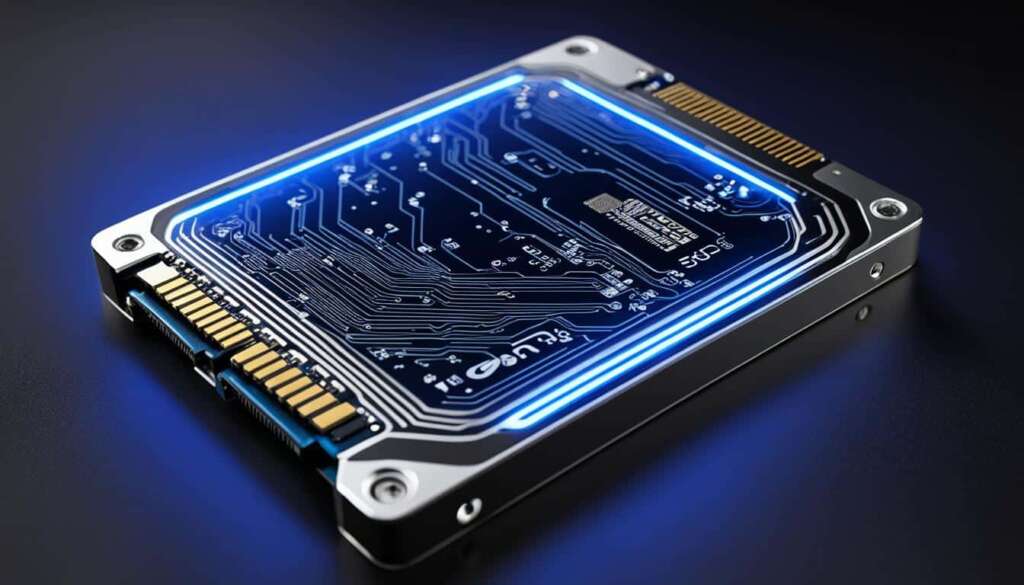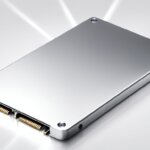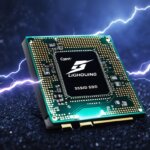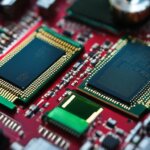Table of Contents
A solid state drive (SSD) is a type of storage device used in computers that replaces traditional hard disk drives (HDDs). SSDs store persistent data on solid-state flash memory, which makes them significantly faster than HDDs. They are used in a wide range of devices, including personal computers, laptops, smartphones, tablets, and more. SSD technology offers higher input/output (I/O) efficiency and lower latency, making it ideal for businesses and individuals who require fast and efficient data storage.
SSDs revolutionize data storage by harnessing the power of solid-state flash memory. Unlike HDDs, which rely on spinning disks and mechanical parts to read and write data, SSDs use non-volatile memory chips. This enables faster access times, shorter boot times, and improved overall performance. With their small form factor, durability, and power efficiency, SSDs are essential components in modern computing devices.
In this article, we will delve deeper into how SSDs work, their major features, advantages, and disadvantages, the types of non-volatile memory used, and the various types of SSDs available in the market today.
How do SSDs work?
SSDs (Solid State Drives) are a fascinating technology that revolutionizes data storage. Unlike traditional HDDs (Hard Disk Drives), SSDs operate on a completely different principle, utilizing advanced flash memory technology.
At the heart of an SSD are the NAND flash memory chips. These chips are responsible for the storage and retrieval of data in the SSD. Unlike HDDs, which rely on spinning disks and a mechanical arm to read and write data, SSDs have no moving parts. The absence of mechanical components makes SSDs more reliable and durable, since there are no fragile parts susceptible to damage from shock or movement.
SSDs use flash memory to store data. Flash memory is a type of non-volatile storage that retains information even when power is removed. It consists of cells made of silicon, known as NAND (short for “NOT AND”) flash memory chips. These chips use logic gates to store data in binary form, with each gate representing a bit (0 or 1).
When data needs to be written to or read from an SSD, the flash controller manages the process. It sends electrical signals to the NAND flash memory chips, determining which cells should be programmed or read. This allows for high-speed read/write performance, surpassing the capabilities of traditional HDDs.
SSDs also employ different types of memory cells, such as Single-Level Cells (SLCs), Multi-Level Cells (MLCs), and Triple-Level Cells (TLCs). Each offers varying levels of performance, capacity, and endurance. SLCs, for example, provide faster read/write speeds and longer lifespan but at a higher cost. MLCs and TLCs, on the other hand, offer greater capacity but with slightly slower performance and reduced endurance.
The use of flash memory and the absence of moving parts give SSDs a clear advantage in terms of read/write performance. SSDs can quickly access data, whether it’s sequential or random, resulting in superior speed and responsiveness. This makes them ideal for tasks that require fast data access, such as booting up operating systems, launching applications, and transferring large files.
“SSDs take advantage of flash memory technology, providing faster read/write performance and unparalleled reliability compared to traditional HDDs.”
Overall, the fundamental principle behind SSDs is the use of flash memory chips to store and retrieve data without the need for mechanical components. This design allows SSDs to deliver exceptional read/write performance, making them the preferred choice for those seeking speed, efficiency, and durability in their storage solutions.
What are the major features of SSDs?
SSDs (Solid State Drives) offer several key features that differentiate them from HDDs (Hard Disk Drives). These features contribute to their superior performance and reliability, making them an attractive choice for various applications.
No Moving Parts and Enhanced Durability
One of the standout advantages of SSDs is that they have no moving parts. Unlike HDDs, which rely on spinning disks and mechanical arms to read and write data, SSDs utilize solid-state flash memory. This lack of moving components makes SSDs more durable and less prone to mechanical failures, providing enhanced reliability for data storage.
Low Power Consumption
SSDs are known for their energy efficiency. Compared to HDDs, which require power to spin the disks, SSDs consume significantly less power during data operations. This not only reduces energy costs but also extends the battery life of portable devices such as laptops and smartphones.
Compact Size and Lightweight
SSDs are smaller in size and lighter in weight compared to HDDs. This compact form factor makes them ideal for portable devices where space is limited. Whether it’s a slim laptop or a sleek smartphone, SSDs provide efficient storage without adding bulk or weight.
Predictive Analytics for Drive Health Monitoring
SSDs incorporate advanced controller software that includes predictive analytics capabilities. These predictive analytics algorithms continuously monitor the health of the SSD, proactively detecting potential drive failures before they occur. This feature enables users to take preventive measures, protecting their data and avoiding unexpected downtime.
Data Reduction Techniques for Optimal Storage Capacity
SSDs employ data reduction techniques to maximize storage capacity. These techniques, which can include compression and deduplication, eliminate redundant data and optimize the overall storage utilization. By reducing the amount of data stored, SSDs can offer more efficient use of available space.
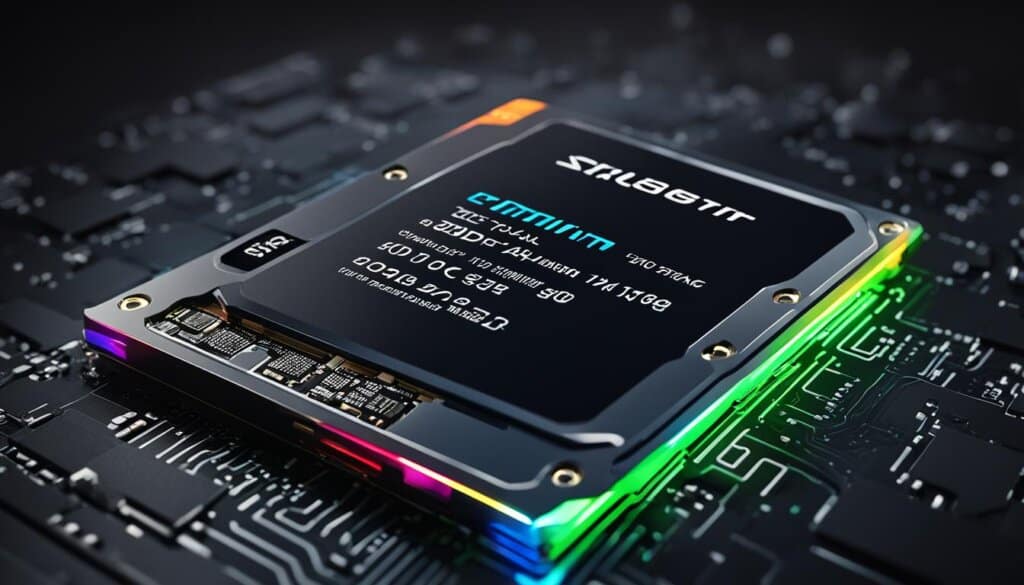
“SSDs are a game-changer in the world of data storage. With no moving parts, enhanced durability, low power consumption, compact size, predictive analytics, and efficient data reduction techniques, SSDs offer a superior and reliable storage solution for a wide range of applications.”
Advantages of SSDs
When it comes to storage technology, solid-state drives (SSDs) have numerous advantages over traditional hard disk drives (HDDs). Let’s explore the key benefits that make SSDs a superior choice for data storage:
- Faster Read/Write Speeds: SSDs offer significantly faster read and write speeds compared to HDDs. This allows for quicker access to large files and improves overall performance, making tasks such as booting up, launching applications, and transferring data faster and more efficient.
- Quicker Boot Times: With faster read and write speeds, SSDs enable quicker boot times for your devices. Whether it’s a computer, laptop, or even a gaming console, SSDs help you get up and running in no time.
- Better Performance: The speedy read and write capabilities of SSDs contribute to better overall system performance. Whether you’re a gamer, a content creator, or a professional requiring efficient data storage, SSDs ensure smooth and lag-free operations.
- Durability: Unlike HDDs, SSDs have no moving parts, which makes them more durable and shock-resistant. This enhanced durability minimizes the risk of mechanical failures and ensures that your data remains safe and intact even in harsh and demanding environments.
- Power Consumption: SSDs consume less power compared to HDDs. As a result, they are more energy-efficient and contribute to longer battery life in laptops, tablets, and other portable devices. This makes SSDs an excellent choice for individuals seeking longer usage times on the go.
- Quieter Operation: With no spinning or moving components, SSDs operate silently, providing a quiet computing experience without the noise typically associated with HDDs. This is particularly beneficial for individuals who value a peaceful and distraction-free work or entertainment environment.
- Size: SSDs are smaller and more compact than HDDs, making them suitable for devices where space is a constraint. Whether it’s an ultrabook, a slim desktop, or a portable device, SSDs offer flexibility in design and allow for more compact and lighter devices.
Overall, SSDs offer a range of advantages over HDDs, including faster read/write speeds, quicker boot times, better performance, durability, lower power consumption, quieter operation, and compact size. These advantages make SSDs the go-to choice for individuals and businesses seeking efficient and reliable data storage solutions.
Stay tuned for the next section where we will explore the disadvantages of SSDs and how they can impact your storage decisions.
What are the Disadvantages of SSDs?
Despite their numerous advantages, solid-state drives (SSDs) also have some disadvantages that should be considered before making a purchasing decision. Understanding these drawbacks is crucial to ensure that SSDs meet your specific needs and requirements. Let’s explore the downsides of SSD technology:
-
Cost: In comparison to traditional hard disk drives (HDDs), SSDs are generally more expensive. The cost per gigabyte (GB) of storage is higher for SSDs, making them less cost-effective for users who require larger storage capacities on a limited budget.
-
Life Expectancy: SSDs have a limited life expectancy, mainly associated with the number of times data can be written to the drive. Each SSD has a specific endurance rating, referred to as the Program/Erase (P/E) cycles. Once an SSD exceeds this threshold, it may become unreliable or fail altogether, requiring replacement.
-
Performance Decrease Over Time: As an SSD reaches its maximum write capacity, its performance may start to decline. Consequently, the read and write speeds can suffer, impacting overall system performance. This performance degradation is known as the “write amplification effect.”
-
Storage Options: While SSDs have become more accessible with increasing storage capacities, they still offer smaller options compared to HDDs. The cost of SSD storage remains a factor in limiting storage sizes, especially for high-capacity requirements.
-
Data Recovery: In the event of a data loss or drive failure, SSDs can pose challenges for data recovery. This is due to the complex structure of SSDs and the way data is stored in memory chips. Data recovery from damaged SSDs can be a time-consuming and expensive process, often requiring professional assistance.
While SSDs provide numerous advantages, it’s important to weigh these disadvantages against your specific needs. Consider factors such as budget, expected usage patterns, storage capacity requirements, and the importance of data recovery before making a decision.
Types of SSD Non-Volatile Memory
When it comes to solid-state drives (SSDs), there are two main types of non-volatile memory used: NAND and NOR flash memory. Each has its own unique characteristics and applications.
NAND flash memory is the most common type of non-volatile memory used in SSDs. It offers fast read times and is primarily used for storage purposes. NAND flash memory stores data in a series of logic gates, allowing for efficient sequential data access. This makes it ideal for tasks such as storing files, documents, and media. It is widely used in various devices, ranging from personal computers to smartphones.
NOR flash memory is generally more expensive than NAND flash memory but offers fast read times and supports random access to data. NOR flash memory is commonly used for executing code and booting up operating systems. It is often found in firmware and BIOS chips. NOR flash memory can access data directly, which makes it suitable for tasks that require random access, such as executing programs.
Many devices, including smartphones, utilize both NAND and NOR flash memory to meet different storage and operational requirements.
| Memory Type | Characteristics | Applications |
|---|---|---|
| NAND flash memory | Fast read times, sequential access | Storage purposes |
| NOR flash memory | Fast read times, random access | Executing code, booting up operating systems |
What are the types of SSDs?
When it comes to solid-state drives (SSDs), there are several types to choose from, each catering to different storage needs and performance requirements. Let’s explore these SSD variants and their unique features.
The first and most common type is the solid-state drive (SSD) itself. These drives offer an affordable and reliable entry point into the world of solid-state technology. They provide faster read/write speeds, improved overall performance, and durability compared to traditional hard disk drives (HDDs).
For those seeking even higher performance, PCIe-based flash SSDs are an excellent choice. These drives leverage the PCIe interface to deliver lightning-fast data transfer rates and lower latency, making them ideal for data-intensive applications.
Another type worth considering is the Flash DIMM. These SSDs eliminate potential bus contention, resulting in reduced latency and improved performance. They are particularly useful for applications that require fast and efficient storage capabilities.
NVMe SSDs, which utilize the non-volatile memory express interface, offer unparalleled performance. With NVMe technology, these drives can achieve incredibly high speeds and lower latency, making them the go-to choice for demanding storage needs.
NVMe-oF, or NVMe over Fabrics, takes things a step further by enabling data transfers between a host computer and an SSD over various protocols. This technology allows for efficient and flexible storage access across networks, making it perfect for data centers and enterprise-level applications.
Lastly, hybrid DRAM-flash storage combines the speed and responsiveness of flash memory with the high throughput of server DRAM. By leveraging both technologies, these drives offer a balanced solution for applications that require a mix of storage capacity and performance.
When it comes to physical form factors, SSDs are available in various sizes and configurations, including 2.5-inch drives, PCIe cards, and DIMMs. This wide range of form factors ensures compatibility with different devices and allows for flexible installation options.
Overall, the different types of SSDs cater to a diverse range of storage needs, from cost-effective solutions to high-performance demands. Whether you’re looking to upgrade your laptop or equip a data center, there’s an SSD type out there that can give your system a significant boost in speed, efficiency, and reliability.
FAQ
What is a solid-state drive (SSD)?
A solid-state drive (SSD) is a type of storage device used in computers that replaces traditional hard disk drives (HDDs). SSDs store persistent data on solid-state flash memory, which makes them significantly faster than HDDs. They are used in a wide range of devices, including personal computers, laptops, smartphones, tablets, and more.
How do SSDs work?
SSDs read and write data to flash memory chips made of silicon. Unlike HDDs, which rely on spinning disks and a mechanical arm, SSDs have no moving parts. The key components of an SSD are the flash controller and NAND flash memory chips. This design allows SSDs to deliver high read/write performance for sequential and random data requests.
What are the major features of SSDs?
SSDs have several features that set them apart from HDDs. Since they have no moving parts, SSDs are more durable and less prone to mechanical failures. They also consume less power, making them more energy-efficient. SSDs are smaller in size and weigh less than HDDs, making them suitable for portable devices. Additionally, the SSD controller software includes predictive analytics to detect potential drive failures in advance. SSDs also offer data reduction techniques to optimize storage capacity.
What are the advantages of SSDs?
SSDs offer several advantages over HDDs. They have faster read/write speeds, allowing for quicker access to large files and improved overall performance. SSDs also have faster boot times compared to HDDs. They are more durable and shock-resistant, thanks to their lack of moving parts. SSDs consume less power, making them more energy-efficient. They operate silently due to the absence of spinning or moving components. Additionally, SSDs come in a variety of form factors and sizes, providing flexibility and options for different devices.
What are the disadvantages of SSDs?
Despite their numerous advantages, SSDs also have some disadvantages. They are generally more expensive than traditional HDDs. Some types of SSDs have a limited life expectancy and can only be written to a specified number of times. Over time, the performance of SSDs may decrease due to the limitations on the number of write cycles. SSDs also have smaller storage options compared to HDDs, mainly due to cost considerations. Finally, data recovery from damaged SSDs can be a time-consuming and expensive process.
What are the types of SSD non-volatile memory?
SSDs use two main types of non-volatile memory: NAND and NOR flash memory. NAND flash memory is commonly used in SSDs and offers fast read times. It uses serial access to data and is primarily used for storage purposes. NOR flash memory, on the other hand, is generally more expensive but has fast read times and supports random access. NOR flash is often used for executing code and booting up operating systems.
What are the types of SSDs?
There are several types of SSDs available. Solid-state drives (SSDs) are the basic type and offer a cost-effective entry into solid-state technology. PCIe-based flash SSDs provide higher performance and lower latency, especially for data-intensive applications. Flash DIMMs offer reduced latency by eliminating potential bus contention. NVMe SSDs use the non-volatile memory express interface for high-performance storage. NVMe-oF enables data transfers between a host computer and a target SSD over various protocols. Hybrid DRAM-flash storage combines flash and server DRAM for increased throughput. SSDs come in various form factors, including 2.5-inch drives, PCIe cards, and DIMMs, offering flexibility for different devices and storage needs.

